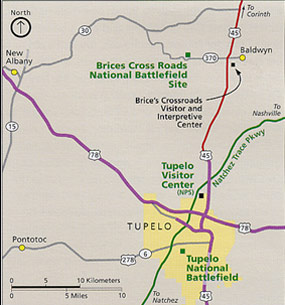| Tupelo National Battlefield | |
|---|---|
 Battle of Tupelo Memorial, 2006 | |
| Location | Tupelo, Mississippi, United States |
| Coordinates | 34°15′20.4″N88°44′13.2″W / 34.255667°N 88.737000°W |
| Area | 1 acre (0.40 ha) [1] |
| Established | February 21, 1929 (War Dept.) August 10, 1933 (NPS) [2] |
| Governing body | National Park Service |
| Website | Tupelo National Battlefield |
| Designated | October 15, 1966 |
| Reference no. | 66000068 |
Tupelo National Battlefield commemorates the Battle of Tupelo, also known as the Battle of Harrisburg, fought from July 14 to 15, 1864, near Tupelo, Mississippi during the American Civil War. The Union victory over Confederate forces in northeast Mississippi ensured the safety of Sherman's supply lines during the Atlanta campaign. [3]
Contents
The 1-acre site on Main Street in Tupelo is a grassy park with a flagpole, memorial monument, and two cannons. There are no visitor services; information is provided at the visitor center for the Natchez Trace Parkway six miles north. The monument and site are very similar to that at Brices Cross Roads National Battlefield Site.


